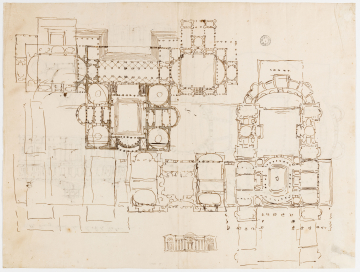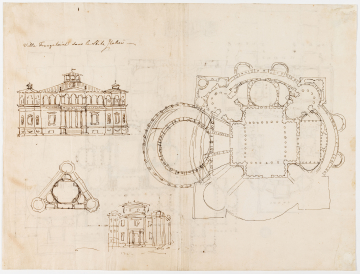Inscribed
Inscribed in ink in a later hand 1; and in a contemporary hand Villa Trangulaire dans le Stile Italien. Inscribed in red ink on album leaf in a nineteenth-century hand First Series (see Index)
Signed and dated
- Undated, probably 1755 - 56
Medium and dimensions
Pen, grey wash340 x 446
Hand
Robert Adam
Verso
Two overlapping plans of large courtyarded public buildings and a small elevation of a two-storied villa. The public building in these plans is shown in greater detail in Adam vol.10/1 (which is signed and dated by Robert Adam as Rome, 1756), and an elevation in Adam vol.10/20, which are illustrated in both Bolton 1922 op.cit., I, p.17 and J. Fleming, Robert Adam and His Circle in Edinburgh & Rome, London, 1962, pl.48.
Watermark
4 lines of names, part of coat of arms, butterfly type
Notes
The inscription on the drawing here may be in Charles-Louis Clérisseau's hand and the fact that it is in French suggests his and Laurent-Benoít Dewez's influence on Robert Adam in this academic study (see also Adam vol.9/5). The simple geometric form of the triangular villa is typical both of French neo-classicism, for example Jean-François de Neufforge's 'Temple de la Guerre' from Recueil Élémentaire d'Architecture (Paris, 1757-68), which Adam owned (see A. Bolton, The Architecture of Robert and James Adam, 2 vols., London, 1922, II, p.330), and of the competitions set by the Roman Accademia di San Luca around this period and earlier (it also appeared in the 1708 competition). A development of the scheme shown here is found in a drawing post-1758 in Adam vol.9/127, where it is adapted as a small English country house. This scheme can also be seen as the early Adam source for the triangular plan of the house at Walkinshaw, Scotland of 1791.
Literature
Rep. A. A. Tait, Robert Adam: drawings and imagination, Cambridge, 1993, pp.163, 166, pl.140; A. A. Tait, Robert Adam, The Creative Mind: from the sketch to the finished drawing, catalogue of an exhibition at Sir John Soane's Museum, London, 1996, p.20.
Level
Drawing
Exhibition history
Robert Adam, The Creative Mind: from the Sketch to the Finished Drawing, Sir John Soane's Museum, 4 October 1996 - 1 March 1997; The Frick Collection, New York, December 1997 - April 1998; Hammer Museum, Los Angeles, May - June 1998; The Octagon Museum, Washington, July 1998 - January 1999; Scottish National Gallery, Edinburgh, February - March 1999
Digitisation of the Drawings Collection has been made possible through the generosity of the Leon Levy Foundation





